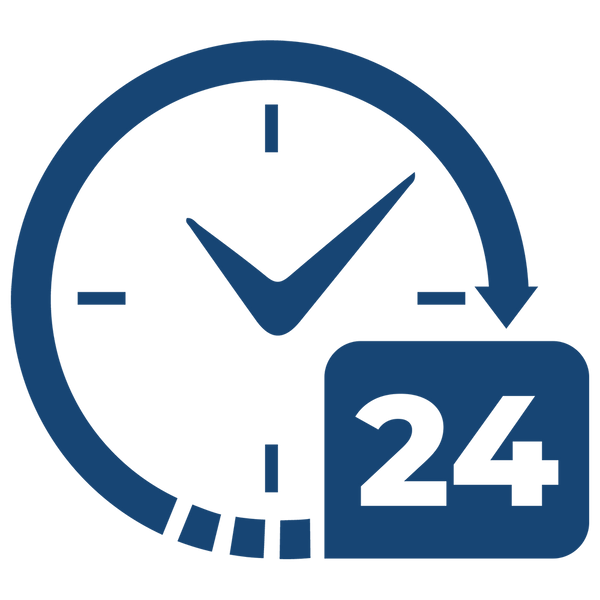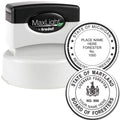Companies thrive on consistent identity. A company logo inspection stamp ensures every product or document reflects a unified design. This single tool can streamline brand recognition and speed up crucial checkpoints.
An inspection mark that includes a recognizable logo helps everyone see which items pass review. Customers also trust a clear, professional seal on packaging or paperwork. Plus, staff no longer need to sign documents by hand or write brand details repeatedly. Instead, a quick press applies the same identifiable image each time. Stamps like these keep operations efficient and reinforce brand presence at every stage.
This post shares practical advice, from ink selection to supplier considerations. Apply these insights and fortify your reputation with a consistent, polished mark on each item.
Use A Company Logo Stamp
Businesses depend on uniform stamping to maintain speed. A specialized logo design highlights brand identity and aids quick checks. Each impression acts as a silent ambassador for your company. Employees spot approved parts instantly and waste less time sorting status updates.
A branded inspection mark can also simplify regulatory compliance. In many fields, items must show proof of inspection. A single imprint can provide batch numbers, dates, or staff initials. This clarity adds accountability since every mark traces back to a specific review step.
On product packaging, these stamps reassure clients. A neat logo imprint indicates that final checks were done. Recipients associate this consistent look with reliability. Over time, these subtle signals shape how people view your craftsmanship. Each impression strengthens the link between your brand and sound quality.
Highlight Brand Consistency
Brand consistency extends beyond letterheads or email footers. It reaches every surface that carries your logo. A crisp, unified logo stamp keeps you looking professional wherever you leave a mark.
When customers see slight variations in your name, confusion can arise. That weakens trust and lowers perceived reliability. A single, cohesive stamp ensures a uniform appearance across multiple items. You look established and attentive to detail, even as a small operation.
Streamlined branding also reduces staff guesswork. Instead of fiddling with multiple designs, teams rely on one proven layout. This saves both time and money, especially when tasks repeat daily. Consistency simplifies your workflow and prevents mislabeling. Your brand remains top of mind in every department, from assembly lines to sales.
In the long run, this focused approach improves customer recall. People connect your clear logo with dependable service. They see the same graphic, form an instant memory, and keep your name in mind.
Improve Quality Control
Effective stamping supports accurate quality checks. Each product or batch can be labeled with a standard logo mark for a clear visual signal. Inspectors see at a glance which goods passed review. Supervisors and auditors also track the steps more easily. This organized method reduces guesswork during compliance audits.
Using a recognizable mark can cut down on manual errors. Handwritten initials might be unreadable, but a logo-based stamp keeps details legible. Production lines often thrive on speed, so a single stamp press boosts efficiency. With the right imprint, you can also assign unique color codes. Green might indicate approval, red a rejected batch, or yellow a hold status. The consistent presence of your logo ensures brand unity throughout these steps.
If you need deeper advice on choosing the right stamping option, consult how to choose an inspection stamp. That resource covers various design types and helps match your workflow needs. Over time, your inspections become simpler and more traceable, thanks to a systemized approach.
Pick Durable Materials
Stamps endure repetitive impacts and varied conditions. Selecting robust materials guarantees long-lasting impressions. Housing components made of metal or high-grade plastic can withstand daily use in busy plants. Solid construction prevents cracking or becoming misaligned.
Rubber quality matters too. Low-grade rubber can wear out, leading to faded images or distorted logos. A higher-grade polymer produces sharper results and holds up to repeated inking. For rougher environments, a durable industrial stamp may prove more reliable. These specialized options tend to endure humidity, oil exposure, and extreme temperatures.
Choose a handle style that fits your speed requirements. Some prefer self-inking units for rapid tasks, while classic wooden handles can last for decades with care. Regular cleaning also stops ink buildup, which can cause blurred lines. Ideally, store stamps in a cool, dry area. Swap out ink pads before they run dry. Thoughtful upkeep preserves the stamp’s accuracy and ensures each impression remains crisp.
Select Suitable Ink
Different surfaces require different ink formulations. Cardboard, plastics, metals, and fabrics might need specialized solutions. An ordinary office ink may smear on slick materials. Meanwhile, a strong solvent-based ink can bond to metal or plastic. If you handle glossy or nonporous items, a fast drying solvent ink stamp might improve workflow.
Color selection also affects visibility. Many companies rely on black or dark blue ink for a polished look. Others opt for bolder colors like red to signal urgency or highlight critical data. The key is picking a shade that pops. If the background is too dark, a pale ink may be tough to read.
Speed matters in high-volume contexts. Quick-drying ink helps staff avoid smudges and reduces waiting time between prints. This keeps production lines moving. Also confirm that your ink meets safety requirements. Low-odor or non-toxic formulations protect workers’ health. A well-matched ink-stamp combination results in neat, durable marks that support consistent branding.
Design An Impactful Stamp
A clean logo design enhances clarity. Too many details can blur when scaled down. Thick lines are safer, as thin or intricate shapes may degrade after repeated use. Test multiple sketches on scrap paper to find the best size. Look for crisp edges, even ink spread, and no unclear elements.
Font choice is critical. Sans-serif fonts often stay clearer when printed at smaller sizes. If your brand uses a scripted font, verify that letters remain legible at stamp dimensions. Keep backgrounds simple to reduce distractions and preserve the central logo or text.
Include only what counts. That might be your company name and a brief tagline. Pack extra details, like barcodes, on a separate stamp if needed. The main mark should tell viewers which organization verified the item. This approach cements accountability and boosts brand exposure.
Work With Top Suppliers
Reliable providers make all the difference in delivering high-quality stamps. Seek out businesses that have a track record in custom solutions. They should offer multiple materials, advanced imprint methods, and a variety of ink types. Ask about lead times too, especially if you run tight production schedules.
A strong example is ESS, a family-owned company operating since 1964. They supply everything from quality control stamps to specialized inspection marks. Their focus on expert craftsmanship and customer satisfaction sets them apart. Many clients praise their efficient turnaround and courteous support. From design consultation to final delivery, ESS guides every step.
Share key details about your production line with your supplier. If you work around oil, mention it. They can recommend specific rubber materials or inks that resist breakdown. The best providers customize solutions to your needs, so you receive a stamp that performs smoothly. Any troubles that pop up are resolved swiftly, preserving your timeline and budget.
Adopt Best Practices
Setting up a proper stamping system eliminates confusion. Keep your logo stamp in a designated area, especially if multiple shifts share it. Label each stamp by purpose. Assign one stamp for daily approvals, another for special checks. This setup makes it easy to grab the right tool.
Train your team on technique. Pressing at the wrong angle or with inconsistent force can produce faint images. A quick orientation helps new hires master the process. Supervisors can monitor stamps for damage or worn-out ink pads. If you want more tips on stamping workflows, see inspection stamp best practices.
Document your stamping procedures too. This fosters consistency, especially if staff rotate positions. Include guidelines on how often to clean dies and re-ink pads. A well-organized approach not only keeps your branding spotless but also supports accurate recordkeeping. The result is reduced guesswork and fewer misprints.
Keep Stamps Effective
Regular maintenance preserves stamp clarity. In dusty settings, store your stamps in a sealed container. Wipe off ink residue or debris at the end of each day. Over time, even small particles can fill in fine lines, causing fuzzy prints. A quick cleaning prevents that buildup.
Re-ink pads as needed, always using the right formula. Test fresh ink on scrap paper before you stamp real products. This ensures everything lines up. If prints look crooked or incomplete, adjust the pad or clean the rubber die. Keeping backup stamps on hand also helps. When one stamp needs servicing, you can grab another and avoid downtime.
Frequent checks save rework costs. Once items are stamped and shipped, errors become costly to fix. By monitoring performance, you ensure every impression stays sharp. This commitment to quality directly protects your brand reputation. Overlooking regular upkeep can result in blurred logos or partial marks. Simple, consistent care keeps your stamp doing its job well.
FAQs
Does a company logo stamp fade quickly?
Well-chosen ink can last a long time. Pairing the right pad and stamp material helps prevent fading or smearing. Regularly refreshing ink pads also keeps prints sharp.Can you stamp on curved surfaces?
Yes, but it depends on the item’s diameter and the stamp’s flexibility. If you must mark curved items often, consider specialized dies or slightly smaller designs.How often should stamps be replaced?
That varies by usage. Proper cleaning and storage extend lifespan. Some durable stamps last for years, especially if you rotate backups and replace ink pads as needed.What if I need multiple designs?
Order a different stamp for each design. You can also explore interchangeable dies. Just confirm each style fits your production flow and keeps brand elements consistent.Is specialized ink necessary for all products?
Not always. Standard inks work on porous surfaces like paper or cardboard. But plastics, metals, or glossy materials may require fast-drying or solvent-based formulas to avoid smudges.


















